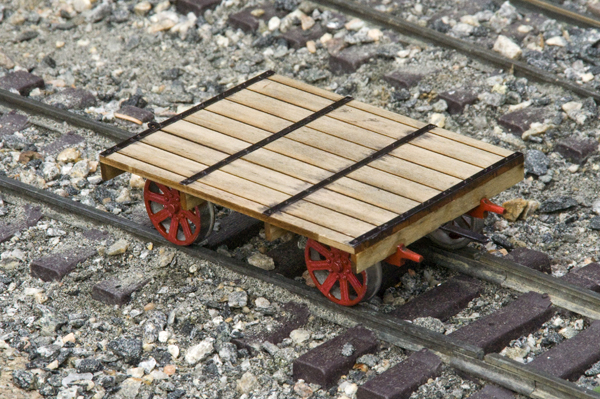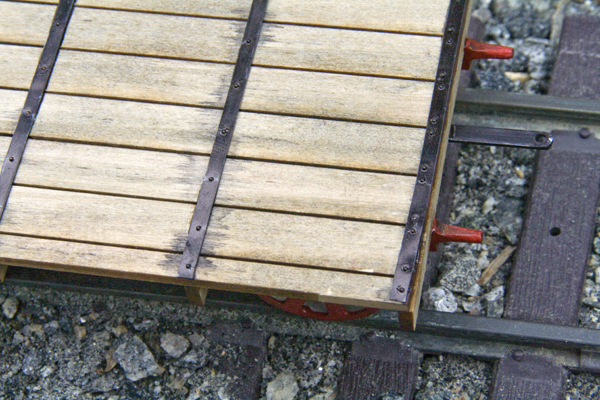Alscad Design
Allen Pomeroy III
PO Box 52
Winchester NH 03470
Price: $19.85 + s&h
Laser-cut wood, metal, and styrene kit for small track-worker’s push cart. Dimensions: 4 3/4″ long over the handles, with the bed measuring 4 1/8 ” x 3″
Pros: Well detailed; easy-to-follow instructions
Cons: Cast wheels difficult to get to run true on axles, making the cart suitable primarily for non-operating display
The kit is fairly simple to assemble and the instructions are straightforward. Included are laser-cut wood parts for the bed and frame, brass for the axles, white-metal castings for the wheels and axle bushings, styrene for the simulated iron straps, and small pins for the rivet details. The laser-cut wood components are of 3/32″ basswood and come in one sheet, from which the modeler removes each part by cutting a small sprue with the tip of an X-acto knife. The instructions recommend staining the bed and cross-brace supports prior to assembly, then gluing the braces onto the bed prior to removing the bed from the laser-cut sheet, as this reduces the chances of the bed breaking during assembly. Good advice, that. The handles can be painted prior to assembly as well.
The kit comes with styrene to simulate the iron reinforcement straps that run along the top of the bed. These, too, can be painted prior to assembly. I used a black permanent marker for this. With the straps glued in place, you have the option of adding the rivet detail (technically, simulated carriage bolts, as the straps would not be riveted onto the wood surface). If you’re modeling using the “10-foot rule,” then chances are few will see the rivets or notice they’re missing. However, this model is detailed enough for close inspection, and the rivets add a nice touch. You must pre-drill the holes, then insert the individual rivets, along with a drop of glue to hold them in place. This is a tedious process but the results are worth the effort. Make sure you’re in a relaxed state of mind when starting out. The tiny rivets can be easily lost if they slip out of the tweezers. Fortunately, the kit comes with extras; I used every last one of mine. For the rivet counters, there are 50 on the finished model.
The wheels come next. This is where you must make some decisions. The provided wheels are accurately scaled white-metal castings. Don’t count on the scale flanges keeping the wheels on the rails if you want to operate this car behind a speeder. For that, you’ll have to source your own wheels and come up with your own bushings to mount them. That’s not a difficult process (outside of finding the wheels in the first place) but it’s also outside of the scope of this review.
I would characterize the wheels on this kit as cosmetic. They will roll, but getting them true on the axles is difficult. Even after chucking the wheels in my lathe, the pre-drilled starter holes were off just enough to leave things a bit wonky. If you’re using a drill press, all bets are off on getting things true. (But, again, the flanges are scale, so these wheels are probably not operable anyway.) The manufacturer tells me he now pre-drills the wheels to simplify the assembly process, so this may be less of an issue. Another thing to keep in mind, though, is that the wheels are not insulated. If there’s power in your rails, they will cause a short. The manufacturer also says that he now includes suggestions in the instructions on how to insulate the wheels, though it’s still something the builder must do on his own.
This is a fun kit to build and can easily be assembled in just a single evening. The end result is a car that will look great sitting trackside with your track-maintenance crew nearby, or stored on a work train, ready for use on the line.
















Back in the 50s this would have been a Model Railroader $1 car project!
I too am interested in electronic contact information. I have added a question to the Large Scale Central forum – https://www.largescalecentral.com/forums/topic/28074/alscad-design-push-cart-kit-vendor-contact/view/post_id/360317
Is there a phone number or e-mail address that can be used to connect with these people so I can find out the shipping cost to order the kit? I am really interest in purchasing one for a kit-bashing project.